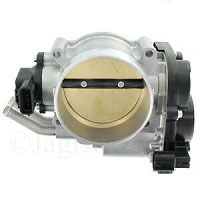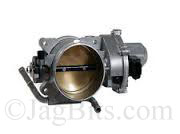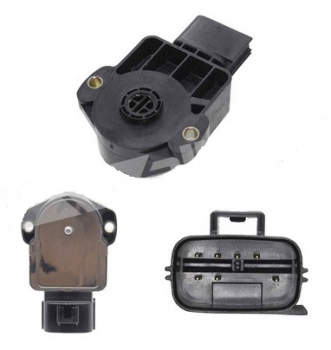By Gary Ilcyn, CEO and Jaguar Enthusiast at Jagbits Inc.
The throttle body and throttle position sensor (TPS) are integral to the engine management system in Jaguar vehicles, particularly in models like the S-Type. Understanding their roles, potential issues, and replacement options is essential for ensuring optimal vehicle performance and longevity.
The Throttle Body: An Overview
The throttle body is a critical component that regulates the airflow entering the engine. This regulation directly influences engine performance, fuel efficiency, and emissions. When the driver accelerates, the throttle body opens to allow more air into the engine, which is then mixed with fuel for combustion. A well-functioning throttle body is essential for responsive acceleration and smooth engine operation.
Understanding the Throttle Position Sensor
The throttle position sensor is a vital feedback device that informs the engine control unit (ECU) about the position of the throttle valve. This information is crucial for the ECU to adjust fuel injection and ignition timing appropriately. A malfunctioning TPS can lead to various performance issues, such as:
- Unstable Idling: Erratic engine idle can occur if the TPS fails to provide accurate position data.
- Reduced Power: If the ECU detects a fault with the TPS, it may limit engine power to prevent damage.
- Throttle Lag: A worn or faulty throttle body can cause delays in throttle response, impacting driving dynamics.
Identifying Common Issues with Throttle Components
Jaguar owners may face several challenges related to the throttle body and TPS. Here are some common symptoms to watch for:
- Check Engine Light: A warning light may illuminate if the ECU detects a problem with the throttle system.
- Inconsistent Performance: Sudden changes in acceleration or deceleration can indicate a malfunctioning throttle component.
- Difficulty Starting: Issues with the throttle body can lead to hard starting or stalling, particularly in cold weather.
Diagnostic Steps for Throttle Body and Sensor Issues
To diagnose problems effectively, consider the following steps:
- Visual Inspection: Check for any visible signs of wear, damage, or loose connections in the throttle assembly.
- Electrical Testing: Use a multimeter to measure the voltage output from the TPS. For instance, pin 2 (green/red) should show battery voltage, while pin 5 (white/blue) should read around 1 volt.
- Throttle Body Cleaning: Accumulated carbon deposits can hinder performance. Regular cleaning can help maintain optimal airflow.
Replacement Options for Throttle Components
If replacement is necessary, several options are available to ensure your vehicle operates smoothly:
| Part | Description | Price Range |
|---|---|---|
| Throttle Body | OEM replacement throttle body designed for various Jaguar models. | $300 – $600 |
| Throttle Position Sensor | Genuine TPS compatible with multiple Jaguar vehicles. | $50 – $150 |
| Throttle Body Assembly | Complete assembly that includes the throttle position sensor for easy installation. | $400 – $800 |
Maintaining the throttle body and throttle position sensor is crucial for the performance and reliability of your Jaguar vehicle. Regular diagnostics and timely replacements can prevent more significant issues, ensuring a smooth and enjoyable driving experience.
Pros and Cons of Throttle Body and TPS Replacement
When considering the replacement of the throttle body or throttle position sensor, it’s essential to weigh the benefits against potential drawbacks. Here’s a breakdown:
| Pros | Cons |
|---|---|
| Improved Engine Performance | Cost of Replacement Parts |
| Enhanced Fuel Efficiency | Labor Costs for Installation |
| Reduced Emissions | Potential for Additional Repairs |
| Better Throttle Response | Time Required for Diagnosis and Repair |
Contact the Author
Gary Ilcyn
Santa Barbara, California, USA
[email protected]
Note:
* This article has been peer-reviewed and held to the highest editorial standards.
** Image may not represent actual part.
Key Considerations Before Replacement
Before proceeding with the replacement of the throttle body or TPS, consider the following factors:
- Vehicle Age and Mileage: Older vehicles or those with high mileage may require more frequent replacements.
- Driving Conditions: Frequent stop-and-go driving or harsh weather conditions can accelerate wear on throttle components.
- Quality of Replacement Parts: Always opt for OEM or high-quality aftermarket parts to ensure compatibility and longevity.
- Professional Installation: While DIY replacements are possible, professional installation can ensure proper calibration and function.
Maintenance Tips for Throttle Components
To prolong the life of your throttle body and TPS, consider the following maintenance tips:
- Regular Cleaning: Periodically clean the throttle body to remove carbon buildup that can impede airflow.
- Check Electrical Connections: Inspect wiring and connectors for signs of wear or corrosion to prevent electrical issues.
- Monitor Engine Performance: Pay attention to any changes in engine behavior, such as rough idling or decreased power, and address them promptly.
- Use Quality Fuel: High-quality fuel can help reduce deposits in the throttle body and improve overall engine performance.
Frequently Asked Questions (FAQs)
1. How often should I replace the throttle position sensor?
Typically, the throttle position sensor should be inspected every 50,000 to 100,000 miles, but replacement may be necessary sooner if symptoms arise.
2. Can I clean the throttle body instead of replacing it?
Yes, cleaning the throttle body can often resolve performance issues. However, if the component is damaged or worn, replacement may be necessary.
3. What are the signs of a failing throttle body?
Common signs include poor acceleration, erratic idling, and the check engine light illuminating. If you experience these symptoms, it’s advisable to have the component inspected.
Last Words…
Understanding the importance of the throttle body and throttle position sensor in your Jaguar vehicle is crucial for maintaining optimal performance. By being proactive about diagnostics, maintenance, and timely replacements, you can ensure a smooth and enjoyable driving experience. Always consult with a professional mechanic if you have concerns about your vehicle’s throttle components.









